Myriostoma coliforme Fr. - Pepper Pot
Phylum: Basidiomycota - Class: Agaricomycetes - Order: Geastrales - Family: Geastraceae
Distribution - Taxonomic History - Etymology - Identification - Culinary Notes - Reference Sources
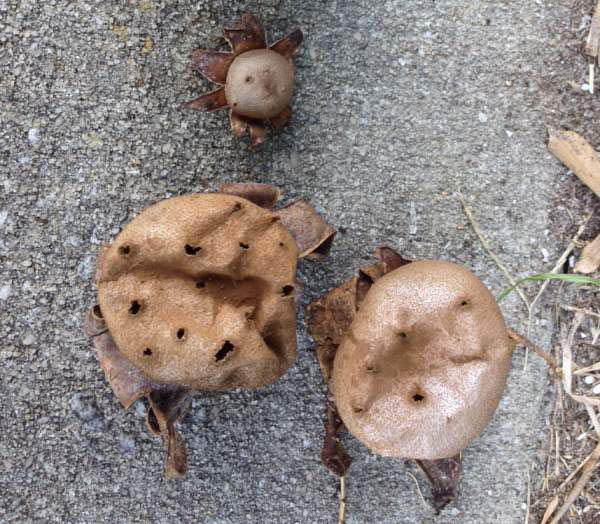
This is a fungal rarity that for more than a century was thought to have become extinct in Britain. In common with other earthstars it is easily overlooked until fully mature. Initially looking like a round stone lying partly buried in the soil, the outer skin (exoperidium) eventually splits into rays that fold back to reveal an inner spore sac (endoperiium) with many ostioles (openings via which spores are released).
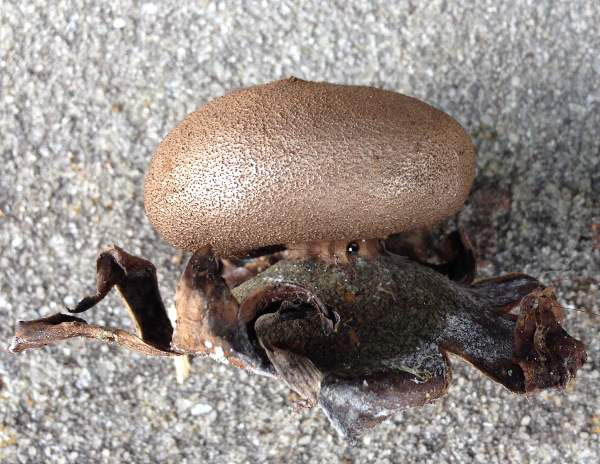
Distribution
Although in the distant past it had been recorded from several locations in England, this earthstar had not been seen there since 1880 until it was rediscovered in 2006 at one of its formerly known sites in Suffolk. Given the 126 year gap between records, it is possible that the Pepper Pot earstar's reappearance was the result of a reintroduction (either intentional or accidental) from mainland Europe, where its known range extends from Scandinavia right down to the Mediterranean. This unusual earthstar is also known to occur in Asia, Africa and the Americas, but the sparsity of records suggests that it is a relative rarity throughout its range.
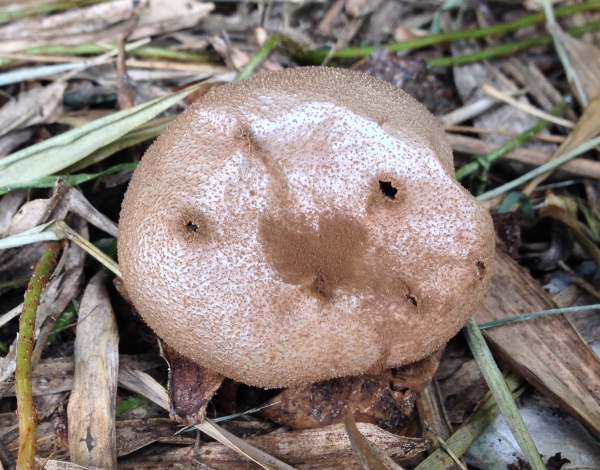
Taxonomic history
The species was described in 1785 by Scottish naturalist James Dickson (1738-1822), who established the basionym when he named it Lycoperdon coliforme (in effect - Classifying it as a puffball). The currently-accepted scientific name Myriostoma coliforme dates from an 1842 publication by the Czech mycologist August Carl Joseph Corda (1809–1849).
Synonyms of Myriostoma coliforme include Geastrum coliformis (Dicks.) Pers., Myriostoma anglicum Desv., Polystoma coliforme (Dicks.) Gray, Geastrum columnatum Lév., and Bovistoides simplex Lloyd.
Etymology
Myriostoma, the generic name, is a reference to the many (myriad) openings (stoma comes from Greek and means a mouth or an opening) via which spores are ejected from the mature fruitbodies. The specific epithet coliforme comes from the Latin noun colum, meaning a strainer, and hence can be interpreted as 'in the form of a colander'. It may seem strange that both parts of this binomial have more or less the same meaning, but it should not cause confusion because to date only one species in this genus has been discovered. Myriostoma coliforme is therefore the type species of a monotypic genus..
Identification guide
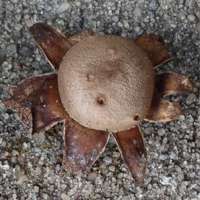 |
FruitbodyAs with other earthstars the fruitbody comprises a mass of spore-bearing gleba encased in a two-layer skin. Young fruitbodies are slightly flattened (oblate) spheroids and very variable in size but generally between 3 and 8cm across. The exoperidium, which is about 5mm thick, splits into a number of more or less equal-sized pointed rays (generally between 5 and 12 but occasionally more). Subspherical (an oblate spheroid), the spore sac is 1.5 to 5cm in diameter, greyish brown and with several irregularly spaced roundish ostioles up to 3mm in diameter via which spores emerge. The gleba, which is brown and powdery when fully mature, is released into the air when raindrops hit the endoperidium. |
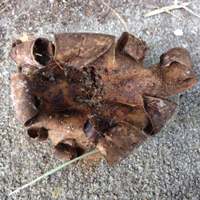 |
When fully expanded, the outer diameter (across the rays) is usually 5-10cm but exceptionally 12cm; however, once the rays curl back they often tuck beneath the fruitbody and raise the spore sac so improving spore distribution. |
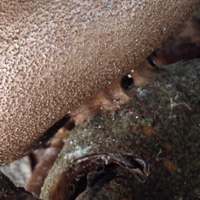 |
StemThe spore sac is connected to the base by a short multi-columned stem typically 5ch tall. |
SporesGlobose, 4-5µm in diameter (excluding warts); ornamented with numerous irregular warts up to 2um tall; inamyloid. Spore massBrown. |
|
Odour/taste |
Not significant. |
Habitat & Ecological role |
Found in leaf-litter-rich soil in deciduous and mixed woodland, particularly under Hazel in dry hedgerows. |
Season |
Fruiting in the autumn; long lasting, and sometimes remaining intact through the winter months. |
Similar species |
Several other earthstars take the same general form, but this is the only one with several ostioles (pore-release openings). |
Culinary Notes
In common with other earthstars, Myriostoma coliforme is an inedible fungus and of no culinary value. In Britain this is a very rare and critically endangered species and so should not be collected.
Reference Sources
Fascinated by Fungi, 2nd Edition, Pat O'Reilly 2016, reprinted by Coch-y-bonddu Books in 2022.
Pegler, D.N., Laessoe, T. & Spooner, B.M (1995). British Puffballs, Earthstars and Stinkhorns. Royal Botanic Gardens, Kew.
Dictionary of the Fungi; Paul M. Kirk, Paul F. Cannon, David W. Minter and J. A. Stalpers; CABI, 2008
Taxonomic history and synonym information on these pages is drawn from many sources but in particular from the British Mycological Society's GB Checklist of Fungi.
Acknowledgements
This page includes pictures kindly contributed by Simon Harding.
Fascinated by Fungi. Back by popular demand, Pat O'Reilly's best-selling 450-page hardback book is available now. The latest second edition was republished with a sparkling new cover design in September 2022 by Coch-y-Bonddu Books. Full details and copies are available from the publisher's online bookshop...

